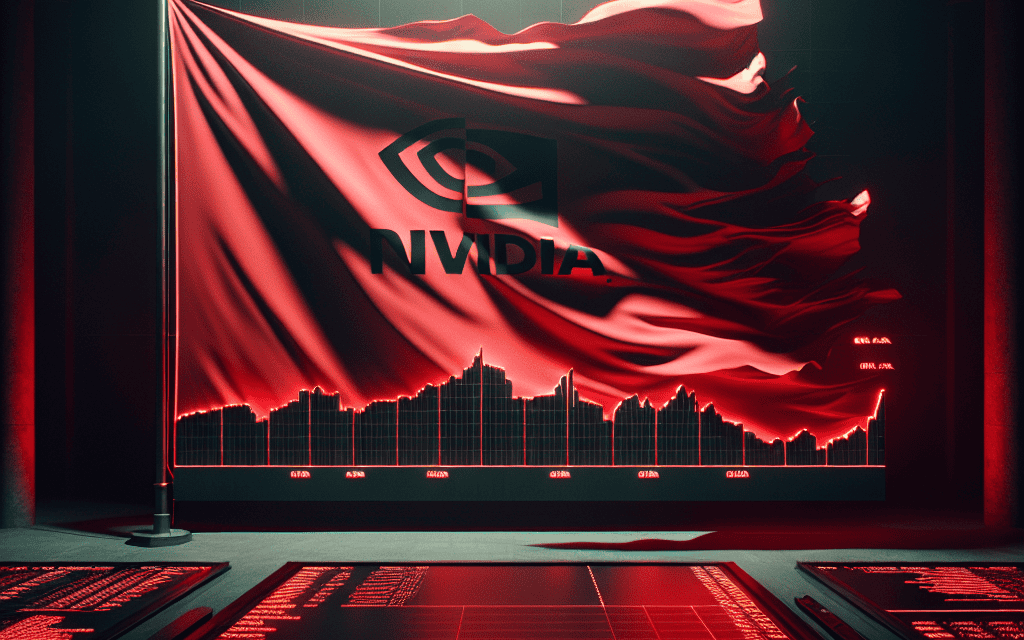“Navigating Uncertainty: Evaluating Potential Risks for Nvidia Investors”
Introduction
Nvidia, a leading player in the semiconductor industry, has consistently captured the attention of investors with its innovative technologies and robust market presence. However, recent developments have raised questions about potential vulnerabilities that could impact its future performance. As the company navigates a rapidly evolving landscape marked by intense competition, regulatory scrutiny, and shifting consumer demands, investors are keenly observing any red flags that might signal underlying challenges. Understanding these potential concerns is crucial for stakeholders looking to make informed decisions about their investments in Nvidia.
Impact Of Geopolitical Tensions On Nvidia’s Supply Chain
Nvidia, a leading player in the semiconductor industry, has long been at the forefront of technological innovation, driving advancements in graphics processing units (GPUs) and artificial intelligence (AI). However, as the company continues to expand its global footprint, it faces a myriad of challenges, particularly those stemming from geopolitical tensions. These tensions have the potential to significantly impact Nvidia’s supply chain, raising concerns among investors about the company’s future stability and growth prospects.
To begin with, the semiconductor industry is inherently global, with complex supply chains that span multiple countries. Nvidia, like many of its peers, relies on a network of suppliers and manufacturers located in various regions, including Asia, Europe, and North America. This global interdependence makes the company vulnerable to geopolitical disruptions, such as trade wars, sanctions, and diplomatic conflicts. For instance, the ongoing trade tensions between the United States and China have already led to increased tariffs and export restrictions, which could affect Nvidia’s ability to source critical components and materials.
Moreover, the semiconductor industry is heavily reliant on Taiwan, home to the world’s largest contract chipmaker, Taiwan Semiconductor Manufacturing Company (TSMC). Given the strategic importance of TSMC, any geopolitical instability in the region, particularly involving China and Taiwan, could have far-reaching implications for Nvidia’s supply chain. The potential for conflict in the Taiwan Strait poses a significant risk, as it could disrupt the production and delivery of semiconductors, leading to supply shortages and increased costs for Nvidia.
In addition to regional tensions, the semiconductor industry is also grappling with the broader implications of national security concerns. Governments around the world are increasingly scrutinizing the supply chains of technology companies, including Nvidia, to safeguard against potential threats. This has led to stricter regulations and export controls, which could hinder Nvidia’s ability to conduct business in certain markets. For example, recent U.S. government restrictions on the export of advanced semiconductor technology to China could limit Nvidia’s access to one of its largest markets, thereby affecting its revenue and growth potential.
Furthermore, the COVID-19 pandemic has underscored the fragility of global supply chains, highlighting the need for companies like Nvidia to diversify their supplier base and reduce dependency on specific regions. While Nvidia has taken steps to mitigate these risks by exploring alternative suppliers and investing in domestic manufacturing capabilities, the process is complex and time-consuming. Consequently, any delays or disruptions in these efforts could exacerbate the impact of geopolitical tensions on Nvidia’s supply chain.
Despite these challenges, Nvidia remains a formidable force in the semiconductor industry, with a strong track record of innovation and adaptability. The company has consistently demonstrated its ability to navigate complex market dynamics and capitalize on emerging opportunities. However, investors must remain vigilant and consider the potential impact of geopolitical tensions on Nvidia’s supply chain when evaluating the company’s long-term prospects.
In conclusion, while Nvidia’s position as a leader in the semiconductor industry is well-established, the impact of geopolitical tensions on its supply chain cannot be overlooked. As the company continues to navigate an increasingly complex global landscape, investors must weigh the risks and opportunities associated with these challenges. By staying informed and proactive, Nvidia can continue to thrive in an ever-evolving market, but the road ahead may require careful navigation and strategic foresight.
Nvidia’s Dependency On Key Customers: A Risk Analysis
Nvidia Corporation, a leading player in the semiconductor industry, has long been celebrated for its innovative graphics processing units (GPUs) and its pivotal role in advancing artificial intelligence (AI) technologies. However, as with any major corporation, there are underlying risks that investors must consider. One such risk is Nvidia’s dependency on a limited number of key customers, which could potentially pose a significant threat to its financial stability and growth prospects.
To begin with, Nvidia’s business model heavily relies on a few major clients, particularly in the data center and gaming sectors. These sectors have been instrumental in driving Nvidia’s revenue growth over the years. For instance, tech giants such as Amazon, Microsoft, and Google are among Nvidia’s largest customers, utilizing its GPUs for cloud computing and AI applications. While these partnerships have been lucrative, they also expose Nvidia to substantial risk. Should any of these companies decide to reduce their reliance on Nvidia’s products or switch to competitors, Nvidia could face a significant decline in revenue.
Moreover, the gaming industry, another critical revenue stream for Nvidia, is similarly concentrated. Major gaming console manufacturers and PC gaming companies form a substantial portion of Nvidia’s clientele. The cyclical nature of the gaming industry, coupled with the rapid pace of technological advancements, means that Nvidia must continuously innovate to maintain its competitive edge. Any failure to do so could result in a loss of market share to competitors, further exacerbating the risks associated with customer concentration.
In addition to these concerns, geopolitical tensions and trade policies can also impact Nvidia’s relationships with its key customers. For example, the ongoing trade disputes between the United States and China have the potential to disrupt Nvidia’s supply chain and limit its access to critical markets. Given that a significant portion of Nvidia’s revenue is derived from international sales, any restrictions on trade could have adverse effects on its financial performance. Furthermore, changes in government regulations or tariffs could lead to increased costs for Nvidia’s customers, prompting them to seek alternative suppliers.
Despite these risks, it is important to acknowledge that Nvidia has taken steps to mitigate its dependency on key customers. The company has been actively diversifying its product portfolio and expanding into new markets, such as autonomous vehicles and edge computing. By doing so, Nvidia aims to reduce its reliance on any single industry or customer, thereby enhancing its resilience against potential disruptions. Additionally, Nvidia’s strong focus on research and development ensures that it remains at the forefront of technological innovation, which is crucial for maintaining its competitive advantage.
In conclusion, while Nvidia’s dependency on key customers does present a red flag for investors, it is not an insurmountable challenge. The company’s proactive approach to diversification and innovation serves as a buffer against the inherent risks associated with customer concentration. Nevertheless, investors should remain vigilant and consider these factors when evaluating Nvidia’s long-term growth prospects. By keeping a close eye on industry trends and potential shifts in customer dynamics, investors can make informed decisions about their investments in Nvidia. Ultimately, understanding the complexities of Nvidia’s business model and its dependency on key customers is essential for assessing the company’s future trajectory in an ever-evolving technological landscape.
Evaluating Nvidia’s Valuation: Is It Overpriced?
Nvidia, a leading player in the semiconductor industry, has been at the forefront of technological innovation, particularly in the realms of graphics processing units (GPUs) and artificial intelligence (AI). As the demand for high-performance computing continues to surge, Nvidia’s stock has experienced significant appreciation, drawing the attention of investors worldwide. However, with this rapid ascent comes the inevitable question: is Nvidia’s current valuation justified, or is it a red flag for potential investors?
To begin with, Nvidia’s impressive growth trajectory can be attributed to its strategic positioning in key markets. The company’s GPUs are not only essential for gaming but also for data centers, AI applications, and autonomous vehicles. This diversification has allowed Nvidia to tap into multiple revenue streams, thereby enhancing its financial performance. Moreover, the company’s commitment to research and development has resulted in cutting-edge products that maintain its competitive edge. Consequently, Nvidia’s robust fundamentals have contributed to its soaring stock price.
Nevertheless, despite these positive indicators, concerns about Nvidia’s valuation have emerged. One of the primary metrics used to assess a company’s valuation is the price-to-earnings (P/E) ratio. Nvidia’s P/E ratio has reached levels that some analysts consider to be excessively high, especially when compared to industry peers. This elevated P/E ratio suggests that investors are willing to pay a premium for Nvidia’s future growth prospects. However, it also raises questions about whether the current stock price accurately reflects the company’s intrinsic value.
Furthermore, the broader market environment must be taken into account. The technology sector, in general, has experienced a bull run, driven by low interest rates and increased digital adoption. This has led to inflated valuations across the board, with Nvidia being no exception. As central banks around the world begin to tighten monetary policy, there is a risk that high-growth tech stocks could face downward pressure. Investors must consider whether Nvidia’s valuation can withstand such macroeconomic shifts.
In addition to market dynamics, competitive pressures pose another challenge. While Nvidia has established itself as a leader in the GPU market, it faces stiff competition from companies like AMD and Intel. These rivals are investing heavily in their own technologies, aiming to capture a larger share of the market. Any advancements by competitors could potentially erode Nvidia’s market dominance, impacting its future earnings and, consequently, its stock valuation.
Moreover, regulatory scrutiny is an aspect that cannot be overlooked. As Nvidia continues to expand its influence, it may attract the attention of regulators concerned about antitrust issues. Any regulatory actions could have implications for Nvidia’s operations and growth strategy, thereby affecting investor sentiment.
In conclusion, while Nvidia’s strong market position and innovative prowess are undeniable, its current valuation presents a complex picture for investors. The high P/E ratio, coupled with potential macroeconomic headwinds and competitive challenges, suggests that caution may be warranted. Investors must weigh the company’s growth potential against these risks to determine whether Nvidia’s stock is indeed overpriced. As with any investment decision, a thorough analysis of both the opportunities and the risks is essential to making an informed choice.
The Competitive Threat From Emerging AI Chipmakers

Nvidia has long been a dominant force in the semiconductor industry, particularly in the realm of graphics processing units (GPUs). These GPUs have become essential for a wide range of applications, from gaming to data centers, and more recently, artificial intelligence (AI). However, as the AI landscape continues to evolve, Nvidia faces increasing competition from emerging AI chipmakers. This competitive threat raises questions about whether Nvidia investors should be concerned about the company’s future market position.
To understand the potential impact of these emerging competitors, it is important to first consider the current state of the AI chip market. Nvidia has established itself as a leader in this space, largely due to its CUDA platform, which has become the de facto standard for AI development. The company’s GPUs are widely used for training AI models, thanks to their parallel processing capabilities and robust software ecosystem. However, the rapid growth of AI applications has spurred the development of specialized AI chips, known as application-specific integrated circuits (ASICs), which are designed to perform specific tasks more efficiently than general-purpose GPUs.
One of the most notable entrants in the AI chip market is Google, with its Tensor Processing Unit (TPU). Google’s TPUs are custom-built to accelerate machine learning workloads, offering significant performance improvements over traditional GPUs for certain tasks. Similarly, other tech giants like Amazon and Apple are investing heavily in developing their own AI chips, aiming to optimize performance for their specific needs. These developments highlight a growing trend towards vertical integration, where companies design their own hardware to complement their software and services.
In addition to these tech giants, a number of startups are also making strides in the AI chip market. Companies like Graphcore, Cerebras Systems, and Habana Labs are developing innovative architectures that promise to deliver unprecedented performance for AI workloads. These startups are attracting significant investment, underscoring the belief that there is room for disruption in the AI chip industry. As these new players gain traction, they could potentially erode Nvidia’s market share, particularly if they succeed in offering more cost-effective or efficient solutions.
Despite these competitive pressures, Nvidia is not standing still. The company continues to innovate, recently unveiling its latest generation of GPUs, which boast improved performance and energy efficiency. Nvidia is also expanding its reach into new markets, such as autonomous vehicles and edge computing, where its expertise in AI can be leveraged. Furthermore, Nvidia’s acquisition of Arm Holdings, a leading designer of mobile processors, could provide additional synergies and opportunities for growth.
Nevertheless, the emergence of new competitors in the AI chip market cannot be ignored. Investors should closely monitor how Nvidia responds to these challenges and whether it can maintain its technological edge. The company’s ability to adapt to changing market dynamics and continue delivering value to its customers will be crucial in determining its long-term success.
In conclusion, while the competitive threat from emerging AI chipmakers is a red flag that warrants attention, it is not necessarily a cause for immediate concern for Nvidia investors. The company’s strong track record of innovation and strategic positioning in the AI ecosystem provide a solid foundation for future growth. However, as the AI chip market continues to evolve, staying informed about industry developments and Nvidia’s strategic responses will be essential for investors seeking to make informed decisions.
Regulatory Challenges Facing Nvidia In Global Markets
Nvidia, a leading player in the semiconductor industry, has long been at the forefront of technological innovation, particularly in the realms of graphics processing units (GPUs) and artificial intelligence (AI). However, as the company continues to expand its global footprint, it faces a myriad of regulatory challenges that could potentially impact its growth trajectory and investor confidence. These challenges, which span across various international markets, are becoming increasingly significant as governments worldwide tighten their regulatory frameworks in response to rapid technological advancements.
One of the primary regulatory concerns for Nvidia is the evolving landscape of antitrust laws. As Nvidia’s market share grows, so does the scrutiny from regulatory bodies concerned about monopolistic practices. For instance, Nvidia’s attempted acquisition of Arm Holdings, a major player in the semiconductor industry, was met with significant resistance from regulators in multiple jurisdictions, including the United States, the United Kingdom, and the European Union. These regulatory bodies expressed concerns that the merger could stifle competition and innovation in the semiconductor market. Although Nvidia eventually abandoned the acquisition, the episode highlighted the regulatory hurdles the company faces as it seeks to expand its influence.
In addition to antitrust issues, Nvidia must navigate the complex web of export controls and trade restrictions that have become more pronounced in recent years. The U.S.-China trade tensions, for example, have led to stricter export controls on semiconductor technology, which directly affects Nvidia’s ability to conduct business in one of its largest markets. The U.S. government has imposed restrictions on the export of advanced chips and technology to China, citing national security concerns. These restrictions not only limit Nvidia’s sales potential in China but also compel the company to reassess its supply chain and manufacturing strategies to mitigate potential disruptions.
Moreover, data privacy and cybersecurity regulations are becoming increasingly stringent across the globe, posing another layer of complexity for Nvidia. As the company delves deeper into AI and machine learning, it must ensure compliance with data protection laws such as the General Data Protection Regulation (GDPR) in Europe and the California Consumer Privacy Act (CCPA) in the United States. These regulations require companies to implement robust data protection measures and provide transparency regarding data collection and usage. Failure to comply could result in hefty fines and damage to Nvidia’s reputation, further complicating its global operations.
Furthermore, environmental regulations are also emerging as a significant concern for Nvidia. As governments worldwide commit to reducing carbon emissions and promoting sustainable practices, Nvidia is under pressure to adopt greener technologies and reduce its environmental footprint. This includes transitioning to more energy-efficient manufacturing processes and ensuring that its products meet stringent environmental standards. While these efforts align with global sustainability goals, they also entail additional costs and operational adjustments for Nvidia.
In conclusion, while Nvidia remains a dominant force in the semiconductor industry, the regulatory challenges it faces in global markets are a cause for concern for investors. These challenges, ranging from antitrust scrutiny and export controls to data privacy and environmental regulations, require Nvidia to adopt a proactive and adaptive approach to compliance. As the regulatory landscape continues to evolve, Nvidia’s ability to navigate these complexities will be crucial in maintaining its competitive edge and ensuring sustained growth. Investors must remain vigilant and consider these factors when evaluating Nvidia’s long-term prospects.
Nvidia’s R&D Spending: Is It Sustainable?
Nvidia Corporation, a leading player in the semiconductor industry, has long been celebrated for its innovative prowess and cutting-edge technology. Central to its success is the company’s substantial investment in research and development (R&D), which has enabled it to maintain a competitive edge in the rapidly evolving tech landscape. However, as Nvidia continues to allocate significant resources to R&D, investors are beginning to question whether this level of spending is sustainable in the long term. This concern arises from the delicate balance between fostering innovation and maintaining financial stability.
To understand the implications of Nvidia’s R&D spending, it is essential to consider the broader context of the semiconductor industry. The sector is characterized by rapid technological advancements and intense competition, necessitating continuous innovation to stay ahead. Nvidia’s commitment to R&D has allowed it to develop groundbreaking products, such as its graphics processing units (GPUs), which have become integral to various applications, including gaming, artificial intelligence, and data centers. This focus on innovation has undoubtedly contributed to Nvidia’s impressive growth and market leadership.
Nevertheless, the question of sustainability looms large. In recent years, Nvidia’s R&D expenses have grown significantly, reflecting its ambition to explore new frontiers and expand its product offerings. While this strategy has yielded positive results, it also raises concerns about the potential impact on the company’s financial health. High R&D spending can strain resources, particularly if the anticipated returns on investment do not materialize as expected. Consequently, investors are keenly observing whether Nvidia can continue to fund its ambitious R&D initiatives without compromising profitability.
Moreover, the semiconductor industry is not immune to economic fluctuations and geopolitical tensions, which can further complicate the sustainability of R&D spending. For instance, supply chain disruptions and trade restrictions can affect the availability of critical components, potentially leading to increased costs and delays in product development. In such scenarios, maintaining high levels of R&D expenditure could become increasingly challenging, prompting investors to question the prudence of Nvidia’s current strategy.
Despite these concerns, it is important to recognize that R&D investment is a double-edged sword. On one hand, it is a vital driver of innovation and long-term growth, enabling companies like Nvidia to pioneer new technologies and capture emerging market opportunities. On the other hand, excessive spending without a clear path to profitability can erode shareholder value and undermine investor confidence. Therefore, Nvidia must strike a delicate balance between pursuing innovation and ensuring financial sustainability.
In addressing these challenges, Nvidia could consider adopting a more strategic approach to R&D investment. This might involve prioritizing projects with the highest potential for commercial success, optimizing resource allocation, and fostering collaborations with external partners to share the burden of research costs. By doing so, Nvidia can continue to innovate while safeguarding its financial health, thereby assuaging investor concerns.
In conclusion, while Nvidia’s R&D spending is a testament to its commitment to innovation, it also presents a potential red flag for investors. The sustainability of this expenditure hinges on the company’s ability to balance its ambitious goals with prudent financial management. As Nvidia navigates the complexities of the semiconductor industry, investors will be closely monitoring its R&D strategy to ensure that it remains a catalyst for growth rather than a cause for concern.
The Implications Of Nvidia’s Stock Volatility For Investors
Nvidia, a titan in the semiconductor industry, has long been a favorite among investors due to its innovative technologies and strong market presence. However, recent fluctuations in its stock price have raised questions about the stability of this investment. Understanding the implications of Nvidia’s stock volatility is crucial for investors who are considering whether to hold, buy, or sell their shares.
To begin with, stock volatility is not inherently negative; it can indicate potential opportunities for profit. However, when a stock exhibits significant fluctuations, it often reflects underlying uncertainties or market reactions to external factors. For Nvidia, several elements contribute to its stock volatility, including the cyclical nature of the semiconductor industry, geopolitical tensions, and rapid technological advancements. Each of these factors can significantly impact Nvidia’s financial performance and, consequently, its stock price.
The semiconductor industry is known for its cyclical patterns, characterized by periods of high demand followed by oversupply. Nvidia, being a key player in this sector, is not immune to these cycles. During times of high demand, such as the recent surge in interest for artificial intelligence and gaming technologies, Nvidia’s stock tends to perform well. However, when the market becomes saturated, or when there is a slowdown in technological adoption, the company’s stock can experience downward pressure. This cyclical nature necessitates that investors remain vigilant and informed about industry trends to anticipate potential shifts in Nvidia’s stock performance.
Moreover, geopolitical tensions can also play a significant role in influencing Nvidia’s stock volatility. The semiconductor industry is heavily reliant on global supply chains, and any disruptions can have far-reaching consequences. For instance, trade disputes between major economies or restrictions on technology exports can create uncertainty and affect Nvidia’s ability to maintain its competitive edge. Investors must consider these geopolitical factors when evaluating the potential risks associated with holding Nvidia stock.
In addition to industry cycles and geopolitical issues, rapid technological advancements present both opportunities and challenges for Nvidia. The company’s success is largely driven by its ability to innovate and stay ahead of competitors. However, the fast-paced nature of technological development means that Nvidia must continuously invest in research and development to maintain its leadership position. While this commitment to innovation can lead to significant breakthroughs and increased market share, it also involves substantial financial risk. Investors should weigh the potential rewards of Nvidia’s technological advancements against the inherent risks of investing in a company that operates in such a dynamic environment.
Furthermore, it is essential for investors to consider Nvidia’s financial health and strategic initiatives when assessing the implications of its stock volatility. The company’s strong balance sheet and history of strategic acquisitions suggest a robust foundation for future growth. However, investors should remain cautious and monitor any changes in Nvidia’s financial performance or strategic direction that could impact its stock price.
In conclusion, while Nvidia’s stock volatility may raise concerns for some investors, it is important to recognize that this volatility is influenced by a complex interplay of industry cycles, geopolitical factors, and technological advancements. By staying informed and considering these elements, investors can make more informed decisions about their Nvidia holdings. Ultimately, understanding the implications of Nvidia’s stock volatility is crucial for navigating the potential risks and rewards associated with investing in this leading semiconductor company.
Q&A
1. **Question:** What recent event has raised concerns for Nvidia investors?
– **Answer:** A potential slowdown in demand for Nvidia’s GPUs, particularly in the gaming and data center markets, has raised concerns.
2. **Question:** How has Nvidia’s stock performance been affected by these concerns?
– **Answer:** Nvidia’s stock has experienced volatility, with fluctuations in its share price as investors react to potential market changes.
3. **Question:** What specific market is showing signs of weakening demand for Nvidia’s products?
– **Answer:** The gaming market is showing signs of weakening demand, impacting Nvidia’s sales projections.
4. **Question:** How is the data center market impacting Nvidia’s outlook?
– **Answer:** While the data center market has been a strong growth area, any signs of slowing investment in AI and cloud infrastructure could impact Nvidia’s future growth.
5. **Question:** What external factors are contributing to the concerns about Nvidia’s future performance?
– **Answer:** Global economic uncertainties, supply chain disruptions, and geopolitical tensions are contributing to concerns about Nvidia’s future performance.
6. **Question:** How are analysts responding to the potential red flags for Nvidia?
– **Answer:** Analysts are mixed in their responses, with some downgrading their outlook on Nvidia while others remain optimistic about its long-term prospects.
7. **Question:** What strategies might Nvidia employ to address these concerns?
– **Answer:** Nvidia might focus on diversifying its product offerings, expanding into new markets, and investing in research and development to maintain its competitive edge.
Conclusion
Nvidia has been a dominant player in the semiconductor industry, particularly with its advancements in graphics processing units (GPUs) and artificial intelligence (AI) technologies. However, potential red flags such as supply chain disruptions, increased competition, regulatory challenges, or overvaluation concerns could pose risks to investors. While Nvidia’s strong market position and innovation pipeline offer growth potential, investors should remain vigilant about these red flags. They should assess the company’s ability to navigate these challenges and maintain its competitive edge. Ultimately, whether these red flags are a cause for concern depends on Nvidia’s strategic responses and the broader market environment.





